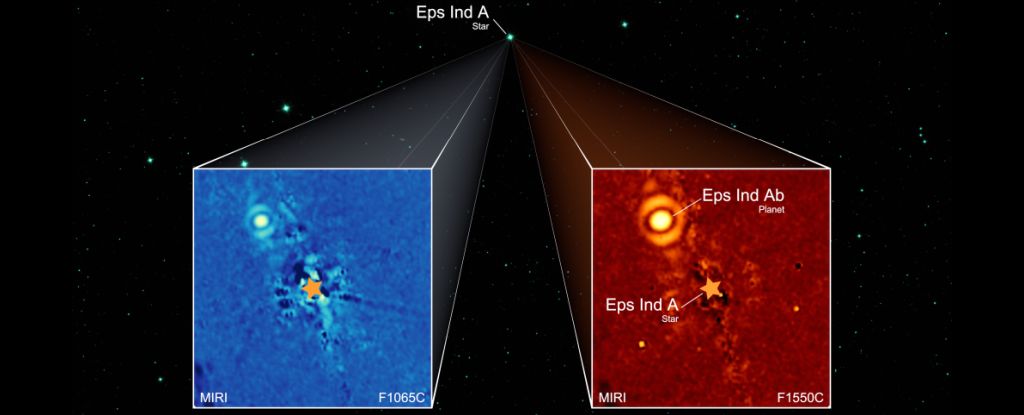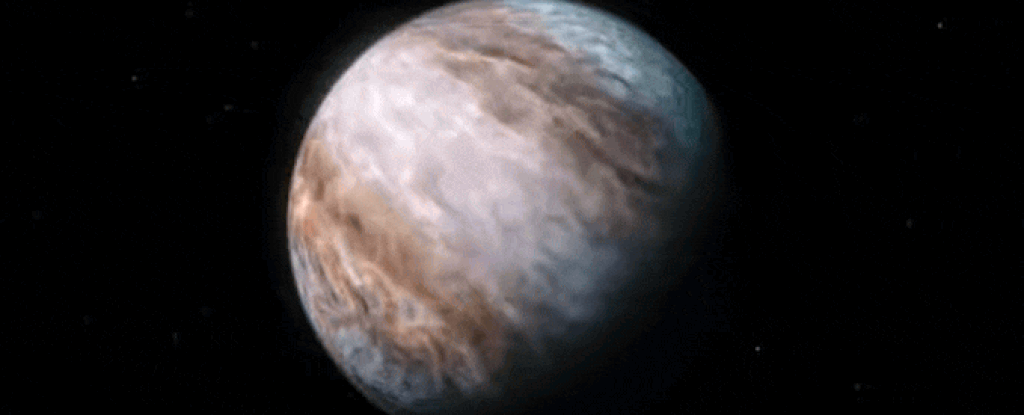Using JWST, astronomers have discovered a new exoplanet; a gas giant they’ve named Eps Ind Ab.
What’s even more exciting is that exoplanet has been imaged directly as a discrete and separate entity independent of observations of its star. It’s also the first exoplanet to have been imaged by JWST without first having been imaged using telescopes on the ground.
The newly discovered world is much colder than any gas giant studied by JWST to date as well; a super- Jupiter orbiting its star with a separation comparable to the distance of Neptune from the Sun.
This makes the discovery a rare treasure among exoplanets, and could be the start of a new stage of exoplanet science.
“We were excited when we realized we had imaged this new planet,” says astronomer Elisabeth Matthews of the Max Planck Institute for Astronomy in Germany.
“To our surprise, the bright spot that appeared in our MIRI images did not match the position we were expecting for the planet. Previous studies had correctly identified a planet in this system but underestimated this super-Jupiter gas giant’s mass and orbital separation.”
To date, astronomers around the world have discovered and confirmed the existence of nearly 5,700 exoplanets, or planets outside the Solar System, but the detection thereof is usually what we call indirect.
That means that we don’t actually see the exoplanet. We see its effect on its host star. An exoplanet passing between us and the star dims the star’s light a little bit, while the exoplanet’s gravitational pull tugs on the star, causing it to appear to wobble, just a teeny tiny bit.
The reason we don’t often see the exoplanet itself is because they are very small, very far away, and any light they may reflect or emit is very dim.
The indirect detection methods also favor larger exoplanets and exoplanets that are very close to their host star, because the exoplanet is more likely to pass in front of the star, and more frequently, meaning the odds of observing it are much, much higher.
But exoplanets that are at a greater orbital distance are more likely to be directly detectable, since a greater distance means less chance their light will be drowned out by that of the star. It’s still pretty hard to do – to date, only around 25 exoplanets have been directly imaged – but it’s a method that helps us learn more about the far reaches of alien planetary systems that are difficult to otherwise study.
Eps Ind Ab’s parent star, Epsilon Indi A, is an orange dwarf star in a triple-star system a mere 12 light-years from Earth. Over long-term observations, astronomers had noticed Epsilon Indi A behaving a bit strangely. It seemed to be moving about as though being gravitationally tugged, not by one of the other two stars in its system, but by a giant world orbiting the star itself.
Properties had been inferred for this tentative exoplanet, but without more data, its identity remained elusive.
This is JWST’s cue. The infrared telescope can detect dim light like no other space telescope that came before, and includes a coronagraph to block the light of the star itself, so Matthews and her colleagues booked time to take a look at the space around Epsilon Indi A.
And they did indeed find something, a bright dot in the star’s orbital space. But, surprisingly, it wasn’t where they thought it would be.
frameborder=”0″ allow=”accelerometer; autoplay; clipboard-write; encrypted-media; gyroscope; picture-in-picture; web-share” referrerpolicy=”strict-origin-when-cross-origin” allowfullscreen>
“We discovered a signal in our data that did not match the expected exoplanet,” says Matthews. “But the planet still appeared to be a giant planet.”
Based on their observations, and archival data, the researchers were able to determine that the dot was indeed an exoplanet, and not some other object at a more distant location. It appears to be a very cold gas giant, with an orbit of around 200 years around Epsilon Indi A, at a distance of around 28 astronomical units. Neptune has a distance from the Sun around 30 astronomical units.
Previous estimates had predicted a world about three times the mass of Jupiter, at a distance of 8.8 astronomical units. This huge difference between what we expected to find, and what we did find, underscores just how valuable direct imaging can be to the study of alien worlds.
We’re not quite done with Eps Ind Ab. The researchers hope that they will be able to take more observations that will provide insights into its atmospheric composition, as well as refine its orbit.
“In the long run, we hope to also observe other nearby planetary systems to hunt for cold gas giants that may have escaped detection,” says Matthews.
“Such a survey would serve as the basis for a better understanding of how gas planets form and evolve.”
The research has been published in Nature.





